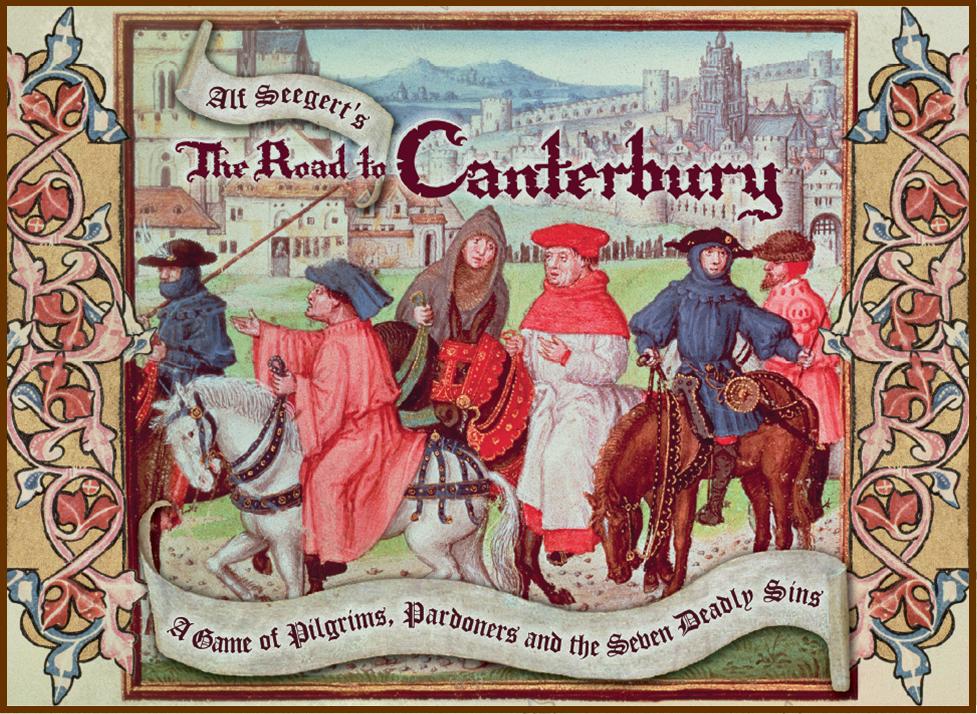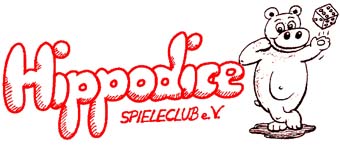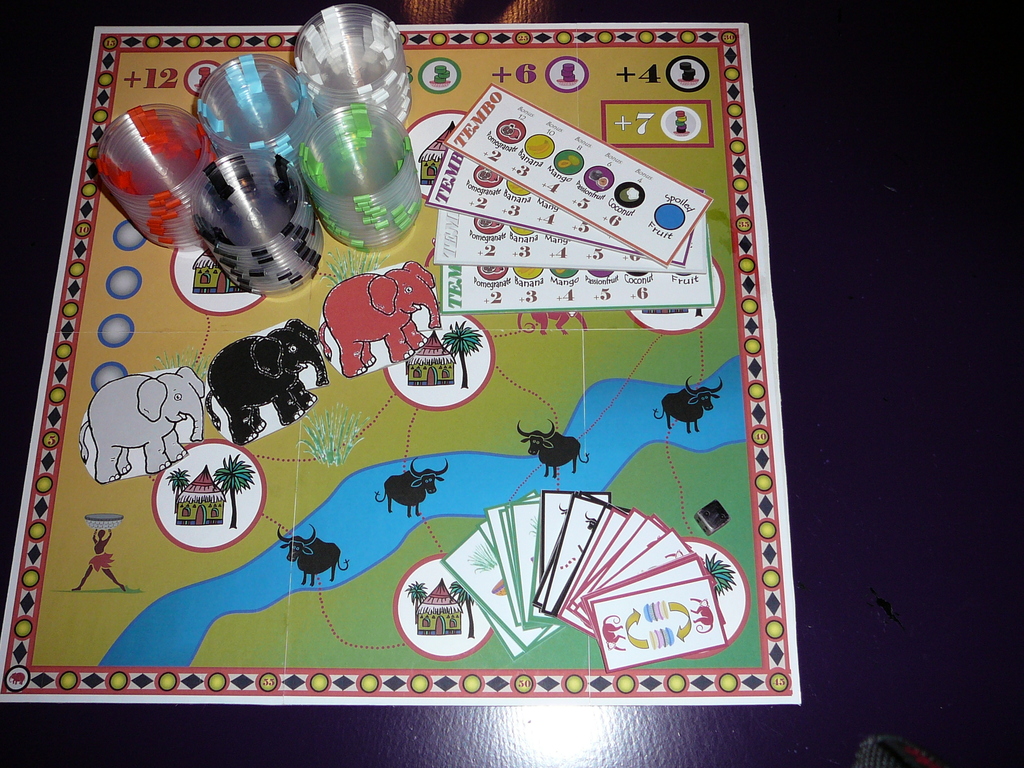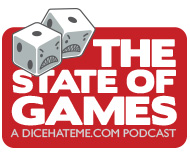Under the Bridge: An Interview with Alf Seegert
 In the world of trolls, Alf Seegert is the man.
In the world of trolls, Alf Seegert is the man.
Wait, let me rephrase that: In the world of troll games, Alf Seegert is the man. Alf is the designer of the outstanding new release Trollhalla (check out my review, if you haven’t done so already), as well as its predecessor and pseudo-prequel, Bridge Troll. Always curious about the names behind the best games, I decided to learn more about this somewhat-unassuming literature professor from Utah – and let me tell you, there’s a lot to learn.
You provide a very in-depth look at the creation process behind Trollhalla on Board Game Geek, but for our readers, what was the kernel of the idea that led to Tembo – the game that would become Trollhalla?
I honestly am not sure. I had the mechanic of stacking pieces on top of one another to direct traveling figures around a board but wanted something more organic than just stone cairns. In thinking about WHY traveler would follow one path rather than another I was reminded of the medieval philosophical paradox of “Jean Buridan’s Ass,” about a miserable donkey which starves to death between two exactly equidistant piles of hay (the reason being that the donkey has no “stronger motive” and can never decide which one to move towards). Well, I wasn’t out to starve anybody, but I figured that stacks of food would be a good motivator for animal transport. I try to discover game themes that are not already well-trodden and a game about elephants at the time—pre-Bombay!—seemed promising. And who doesn’t like elephants?
Well, the jury at Hippodice seemed to like my elephant game a lot (“Tembo,” incidentally, is Swahili for elephant). I came in third place out of hundreds of international competitors, and two major European publishers showed a lot of initial interest. But as an elephant game, it was simply not “meant to be,” I guess.
And why Trolls? I know the theme for Trollhalla extends the theme and story from your previous game, Bridge Troll. But where did the original troll idea come from? Were you traumatized by a goat when you were a child?
Well, I was once reprimanded for my particularly appalling performance as one of the Billy Goats in a second-grade production of “The Three Billy Goats Gruff.” Second-grade, third rate. So perhaps I’ve become a troll sympathizer out to “get somebody’s goat?”
Ahem.
Actually, I seem to have always had trolls as part of my basic story-grammar. My mother is Danish and says that in her childhood a particular bridge in Logumkloster, Denmark always terrified her for its dark underbelly. She went in for the “lighter” variety of trollishness, however, and was fond of the freaky wild-haired Scandinavian “Troll dolls” of the 1970s. And then in the 80s I became an avid player of Ken St. Andre’s delightful role-playing game Tunnels & Trolls, so I guess that my basic grammar of fun and gameplay has always been fundamentally trollish.
Predictably enough, I’m now in somewhat regular contact with Ken St. Andre because he runs the official Tunnels & Trolls fansite as the Trollgod of Trollhalla. (The origin and coincidental naming of my own game as “Trollhalla” I explain in my Designer Diary on Board Game Geek.)
The video tutorial for Trollhalla features music created by you as a sort of “soundtrack” for Trollhalla. When you see one of your designs start to come into focus, does a musical track automatically come to mind? Do each of your games have soundtracks?
 Alas, no! I’m mostly a guitarist, so I guess I’ll have to broaden my repertoire to achieve that! My next game is set in 14th century England so I will have to brush up on my lyre and lute! No, so far Trollhalla is the only game I’ve written music for. Although there are no vocals recorded, here are some of my proposed lyrics:
Alas, no! I’m mostly a guitarist, so I guess I’ll have to broaden my repertoire to achieve that! My next game is set in 14th century England so I will have to brush up on my lyre and lute! No, so far Trollhalla is the only game I’ve written music for. Although there are no vocals recorded, here are some of my proposed lyrics:
TROLLHALLA
Sailing to Trollhalla! Sailing to Trollhaaaaa!
Sailing to Trollhalla! Sailing tra-la-la!
Fill my ship with Princesses
Do not forget the cow
Monks’ outfits look like dresses
So dangle them from the prow
Sailing to Trollhalla! Sailing to Trollhaaaaa!
Sailing to Trollhalla! Sailing tra-la-la!
Billy Goats make good snack food
Peasants with pigs are nice
Noblemen’s purple dressings
Help me keep off the lice
My Grog-addled Troll is a He-man
So come buy this game from Z-Man…
Pink Lady Troll is a She, Man
So come buy this game from Z-Man…
Sailing to Trollhalla! Sailing to Trollhaaaaa!
Sailing to Trollhalla! Sailing tra-la-la!
You seem to have always been a connoisseur of interesting game mechanics. Are there any that you have come across at competitions or created yourself recently that you can mention?
Although I’m all for cross-fertilization between game designs, I’m most inspired by designers who look outside of other games for both themes and mechanics. For example, in Jesse Schell’s book The Art of Game Design, he tells a story about a juggler whose performance is vastly more inspiring than other jugglers. His secret? He finds inspiration in nature, the movements of animals, everything EXCEPT other jugglers.
 I try to take that advice to heart. My game Bridge Troll was inspired by a statue of a woman in downtown Salt Lake who is leading sheep across a bridge—and I imagined how silly and fun it would have been to stick a wild-haired troll doll beneath it to extort her for crossing! That got me to thinking about how I might turn that into a game…..
I try to take that advice to heart. My game Bridge Troll was inspired by a statue of a woman in downtown Salt Lake who is leading sheep across a bridge—and I imagined how silly and fun it would have been to stick a wild-haired troll doll beneath it to extort her for crossing! That got me to thinking about how I might turn that into a game…..
Likewise, in my upcoming game The Road to Canterbury, I was inspired less by other games and more by literature (this is a handy thing, considering that I am a professor of literature by profession). Chaucer, for example, gave me some wonderful game ideas. In his fourteenth-century poem The Canterbury Tales, the character of the Pardoner outright admits that he is a fake out to fleece the other pilgrims by convincing them of their abject sinfulness, which makes his services a high demand item: he offers fake relics and bogus pardons as consolation. This sounded like fun to me, and the Pardoner seemed like a promising villainous character to play in a game. Before long, the game “wrote” itself—and because literature inspired me, I feel like the game is in fact Chaucerian rather than a bunch of abstract mechanics with a theme pasted on at the last minute.
You are part of the Board Game Designers Guild of Utah, which is a very interesting organization. Can you tell us more about it? How did the whole thing come about?
 Four years ago Greg Jones, then the manager of Game Night Games in Salt Lake City, pulled together several different aspiring designers to make a formal game design club. I was part of that early group, which became the Board Game Designers Guild of Utah (BGDG). Now we have dozens of members who meet regularly to develop their game designs. The sort of feedback generated at our meetings is very helpful for polishing one’s designs—or, in some cases, for re-working or abandoning existing ideas entirely!
Four years ago Greg Jones, then the manager of Game Night Games in Salt Lake City, pulled together several different aspiring designers to make a formal game design club. I was part of that early group, which became the Board Game Designers Guild of Utah (BGDG). Now we have dozens of members who meet regularly to develop their game designs. The sort of feedback generated at our meetings is very helpful for polishing one’s designs—or, in some cases, for re-working or abandoning existing ideas entirely!
Several members of the BGDG are now published or will be shortly, including Sean MacDonald (Pastiche, FRED/Gryphon Games), Mike Compton (The Heavens of Olympus, Rio Grande Games), Ben Stanley (Symbol, Nestor Games), Scott Nelson (Food Fight, TOG), Sandeep Kharkar and Dave Haslam (King’s Vineyard, Mayday Games), Mike Drysdale (Hagoth: Builder of Ships, Mayday Games) and others. Check out the BGDG website for more — it’s really impressive to see the amount of creative output from this one group.
Can you tell us a bit about projects you’re currently working on and hope to produce?
 The Road to Canterbury is set for summer release from FRED/Gryphon Games. I have several other games in the works as well, including two currently being evaluated by publishers, but until they are announced I had better keep mum!
The Road to Canterbury is set for summer release from FRED/Gryphon Games. I have several other games in the works as well, including two currently being evaluated by publishers, but until they are announced I had better keep mum!
What are some of your favorite games? What games you have played or seen have influenced you the most?
I’m not as current as I could be with games; I seem to find little time lately to play! But my favorite games tend to be rich in both theme and mechanics. The Princes of Florence is pretty close to the “perfect game” in my view. I like Smallworld very much. Although it didn’t inspire my actual game design for Trollhalla (my rules preceded it) its clever use of tiles for everything was inspiring. Stone Age is delightful. I wish I had time for the glorious and gloriously complicated The War of the Ring, but alas….
An oldie but a goodie I adore is Klaus Teuber’s Adel Verpflichtet, aka By Hook or Crook, aka Hoity Toity. Some growl at the chaos but I consider its simultaneous play mechanism to be brilliant and it certainly has inspired my own work (for Bridge Troll, anyway). This year’s Spiel Des Jahres winner DiXit is so beautiful and evocative, and that beauty and mysteriousness certainly move me.
 Although I don’t design video games, I’m inspired as a designer by the work of Fumito Ueda and Team Ico, authors of Ico, Shadow of the Colossus, and the upcoming Last Guardian. Ueda’s aesthetic vision and his approach that he calls “design by subtraction” is hugely inspiring to me. His games have very little “interface” visible at all. There are no convoluted statistics to keep track of, but the games still enrapture and immerse—more so than most stat-based role-playing games, in fact. In short, Ueda’s vision has taught me as a designer how to sculpt, rather than paint. Instead of adding stuff until you are finished, you take away until you can’t remove anything else. I can trace my own evolution exactly this way. If you look at the rules for my early design, Bridge Troll (first devised around 2002 but not published till much later) they are nifty but a bit convoluted and involved. Stat-friendly role playing gamers have no trouble with them, but the average family—unless they are gamers—will be bewildered.
Although I don’t design video games, I’m inspired as a designer by the work of Fumito Ueda and Team Ico, authors of Ico, Shadow of the Colossus, and the upcoming Last Guardian. Ueda’s aesthetic vision and his approach that he calls “design by subtraction” is hugely inspiring to me. His games have very little “interface” visible at all. There are no convoluted statistics to keep track of, but the games still enrapture and immerse—more so than most stat-based role-playing games, in fact. In short, Ueda’s vision has taught me as a designer how to sculpt, rather than paint. Instead of adding stuff until you are finished, you take away until you can’t remove anything else. I can trace my own evolution exactly this way. If you look at the rules for my early design, Bridge Troll (first devised around 2002 but not published till much later) they are nifty but a bit convoluted and involved. Stat-friendly role playing gamers have no trouble with them, but the average family—unless they are gamers—will be bewildered.
With Trollhalla I wanted sculpture, not painting. I kept Ueda’s approach in mind for keeping the rules simple while keeping the gameplay complex—“simplexity” is a good word for it. This combination, along with the beauty provided by Ryan Laukat’s stunning artwork, I find very pleasing. So far, players seem to agree—which is of course a good thing!
And, finally, something I like to ask all successful designers: What tips do you have for fledgling designers looking to get their creations in the hands of eager gamers?
I can only speak of what worked for me, and I definitely lean toward Euro-style designs. Specifically, I began by polishing my designs and regularly entering them into the Hippodice Board Game Design Competition in Germany.
 Entering a game into the Hippodice competition helps designers because a) deadlines are your friend and b) the playtesters at Hippodice are not. Contest deadlines ensure that you can’t just take forever on your design (the adage “real artists ship” applies here). And if your goal is to get published, it’s crucial to get your designs played by people who don’t know you but who do know the business of board gaming. If friends and family love your game, that’s great—but it’s not a reliable guide to what actually will get published and played by people who don’t know you. You need feedback from testers who would not hesitate to say (in designer Phil Kilcrease’s immortal words), “Your baby is ugly.” The jury at Hippodice is composed of various Eurogame publishers, as well as jury members for Spiel Des Jahres, so you know you’re getting your game evaluated by people who know and love Eurogames, and moreover know the business of publication inside-out.
Entering a game into the Hippodice competition helps designers because a) deadlines are your friend and b) the playtesters at Hippodice are not. Contest deadlines ensure that you can’t just take forever on your design (the adage “real artists ship” applies here). And if your goal is to get published, it’s crucial to get your designs played by people who don’t know you but who do know the business of board gaming. If friends and family love your game, that’s great—but it’s not a reliable guide to what actually will get published and played by people who don’t know you. You need feedback from testers who would not hesitate to say (in designer Phil Kilcrease’s immortal words), “Your baby is ugly.” The jury at Hippodice is composed of various Eurogame publishers, as well as jury members for Spiel Des Jahres, so you know you’re getting your game evaluated by people who know and love Eurogames, and moreover know the business of publication inside-out.
If you do well at the Hippodice competition (or, I suppose, at one of the numerous other competitions offered each year) it’s a great way to get your work noticed by the industry. Several of my own designs which were finalists at Hippodice went on to be looked at by top publishers in the industry, and two of these have been published so far: Bridge Troll was a top-ten Hippodice finalist in 2005 and published by Z-Man in 2009; TEMBO came in third place in 2008 and was rethemed and published as Trollhalla, also by Z-Man Games. Well-known designs that were originally Hippodice finalists include Mississippi Queen, Portobello Market, Himalaya, and Planet Steam. A small sampling of designers who were at one time Hippodice finalists includes Stefan Dorra, Uwe Rosenberg, Doris Matthäus and Frank Nestel, and Michael Schacht.
For details on the contest, see the official website at www.hippodice.de (at the site, click “Autorenwettbewerb” and then “Rules and Description” to get the English instructions). A list of Hippodice winners has been compiled and is available at Board Game Geek.
On a side note, you’re totally a Gemini, aren’t you?
Totally!
Much thanks to Alf Seegert for the time and effort in making this interview possible. For more on Trollhalla, be sure to check out the Dice Hate Me review, and look for more thoughts from me and Monkey238 in The State of Games, Episode 4 – The One About the 7 Deadly Sins.
Related posts:
- Great Odin’s Goat! A Trollhalla Review
- Before Nightfall: An Interview with Todd Rowland of AEG
- Where the Games Are
- Private: Cards Against Humanity: An Offensive Interview
- Interview Fu – A Chat with Cookie Fu Designer Brian Kowalski
Comments
3 Responses to “Under the Bridge: An Interview with Alf Seegert”Trackbacks
Check out what others are saying...-
[…] game and learn a bit more about Alf and his many passions in the in-depth Dice Hate Me interview over here. Also mentioned in the podcast is Hieronymous Bosch’s famous painting The Seven Deadly Sins […]



This is a good interview. I read the review of Trollhalla and the game seems fun with some interesting mechanics. I always enjoy hearing from designers (see Go Forth And Game for some of my interviews). I appreciate Alf’s talking about his inspirations. It is good to hear about Canterbury Tales guiding his next game. Literature is a great well to go to for game ideas. BGDG is an excellent idea. Wonder if there is anything in our area like this? The idea of sculpting a game is very neat. Design by subtraction – I like that and it makes sense.
Thanks for the interview.
tomg
Tom – Thanks! Alf is a great guy, and I’m glad that he’s created such a fun game. As for a board game designers guild in our area – I’ve never heard of such a thing. But asking Alf about BGDG got me thinking that we could certainly use one… let’s talk about this soon. 🙂